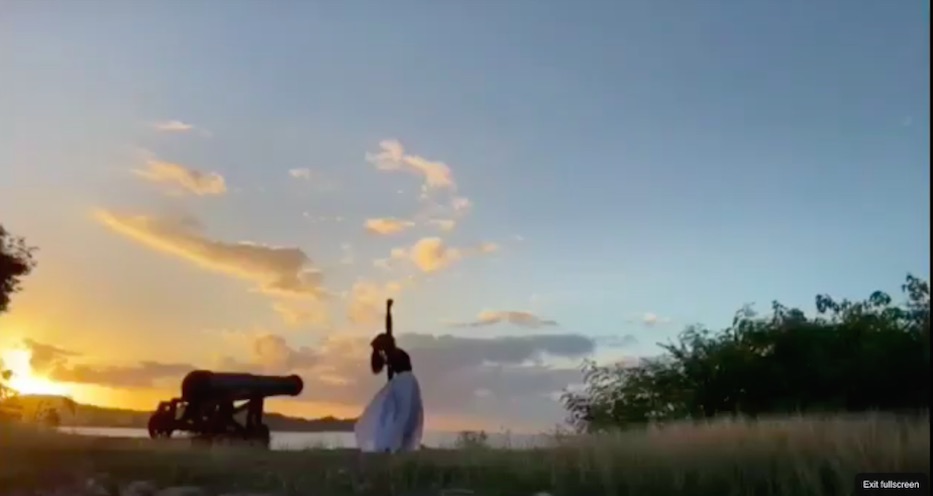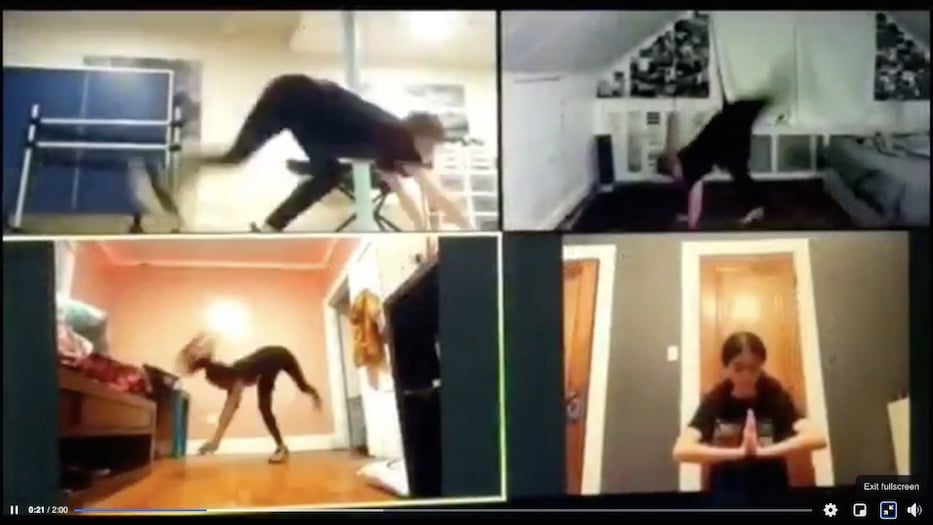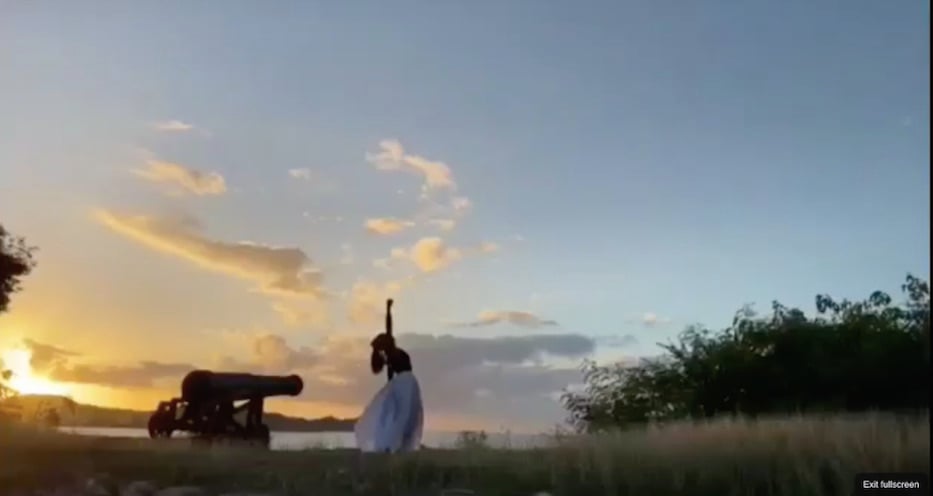
Dance | Dr. Martin Luther King Jr. | Arts & Culture | COVID-19

Members of NMS' Premiere Dance Company from the preview of Recollection Connections. Screenshot from Facebook Live.
The images flashed across the screen, gone almost as quickly as they appeared. Across four on-inch boxes, dancers crouched and sprang heavenward. The scene shifted: dancer Hanan Hameen looked straight ahead, her eyes locked on the viewer. It shifted again: a dancer stood alone, her body between sea and sky. Poetry floated over the frame, even-keeled as it spoke four centuries of history into being.
So unfolded Recollection Connections, a new work from Artsucation Academy Network founder Hanan Hameen and members of the Senegal-based M’Bosse Dance Company, Keepers of the Culture Performing Arts Company, and Premiere Dance Company at Neighborhood Music School. Monday, the work made its premiere as part of a 25th annual celebration of Dr. Martin Luther King, Jr. at the Yale Peabody Museum of Natural History.
Hameen said that the piece, which ran 40 minutes online, was designed primarily to honor and continue King’s legacy. In the midst of national white terror and the twin pandemics of Covid-19 and white supremacy, it also provided both a balm and a fierce call to action.
“He fought so that everyone could stand up and say who they were—human beings,” Hameen said of King at the top of the video. “He understood that while yes, hoping for a united future, he understood the realities of who we were and where we came from. He understood that we need reparations. He understood who we are as a people, and that for us to excel and achieve, we had to connect together.”
The finished video is a work that brings together dancers working across two continents, several generations, and countless WiFi connections, computer screens, and editing programs. To those layers, Hameen has layered rich oral and visual history into the work, with decade-spanning music and archival photographs in black and white, and color. Monday, excerpts of King’s “I Have A Dream” address came in and out of the frame, crackling to life in his deep, tremulous voice.
As dancers joined in pre-recorded videos, the whole film functioned as a sum of its parts. In one vignette toward the beginning, members of the M’Bosse Dance Company fanned out across a sandy lot, Hameen regal as she entered slowly behind them. As they danced, she stood to one side, acting out the violence of colonialism as she lifted a staff over a dancer and brought it swiftly down. Slowly, they synchronized their movements, as if moving parts of a single mind.

Keepers of the Culture Performing Arts Company Dance Captain Reina Pelle-Joseph. Screenshot from Facebook Live.
In another titled “The Land Of The Free,” Keepers of the Culture dance captain Reina Pelle-Joseph stood alone on a stretch of land, wrapped in a white skirt and the yellow-green of long, uncut grass. Just feet away sat an old cannon, hollow and still foreboding. Beyond it, a river reached out to meet the sky. From a low camera angle, Pelle-Joseph looked as if she was alone.
To Cynthia Erivo’s “Stand Up,” she began to move, her arms certain as they rose against the horizon line. Her feet summoned her forward. Taking all the time they needed to, her limbs became a sort of call-and-response with the wind. A leg lifted, slow and steady. Her torso bent towards the land and back sky. Erivo’s voice came through the frame, deep and clear. From screens across multiple states and countries, Pelle-Joseph danced through the words, always moving forward.
Later in the video, that energy flowed to dancers Earl Ali-Randall and Shannon Dickey. Their bodies became electric in a New Haven parking lot, feet flying. Beyoncé's “My Power” landed in time with their footfalls, their arms kinetic and jubilant as they sliced through the fresh air.
The scene shifted. NMS students filled the frame one by one, each introducing a work that they had devised and rehearsed for their classes. In a Zoom-partitioned sea of winding torsos, windmilling arms, pointed feet and extended limbs, they wove a through line from one pandemic to another, bridging the rite of human touch and an epidemic of state-sanctioned violence.
Through the two, being Black has become a uniquely American comorbidity. As students lifted up the names of Black people killed by the police, their limbs kept moving as if in graceful protest. Activist Tamika Mallory boomed over the frame like a sermon: “It has not been free for Black people and we are tired. Don’t talk to us about looting. Ya’ll are the looters! America has looted Black people!”
While dance may be the primary language of the video, Hameen’s youngest students also spoke powerfully to the moment. In introducing her work, one student mentioned missing hugs with her friends, then added that she is shaken by the amount of unprovoked violence she has seen in the past year. Another dove into a project exploring the emotional and mental stress of Covid-19, her arms flung forward on her bedroom carpet in a gesture of helplessness. A third said she spends time wondering whether she could be the next victim of police brutality.
If the video took a risk—sewing together footage from multiple dancers on multiple continents in the midst of two pandemics—it worked. By the time Hameen returned to the screen in back-to-back performances, dancers had turned their craft into both an homage to the Civil Rights Movement and a powerful case for reparations.
As Hameen took the dance floor to Trey Songz’ “2020 Riots: How Many Times,” she became a force herself, her body gliding, falling, and rising in a confined space. Behind her, historical photos and printouts with the words “Reparations now!” and “Stop police brutality” looked out at a viewer. She let the words guide her, her skirt flying as she spun in the small room. She moved through grief, flinging herself against one wall. She fell and rose once more. She cleansed the space with white sage, a new beginning to history.
The scene shifted once more. Only a few minutes remained. Hameen stood on a beach in Senegal, surrounded by dancers. She lifted her hands. Then she ended the film the only way it felt she could have: with a multigenerational call to dance.

